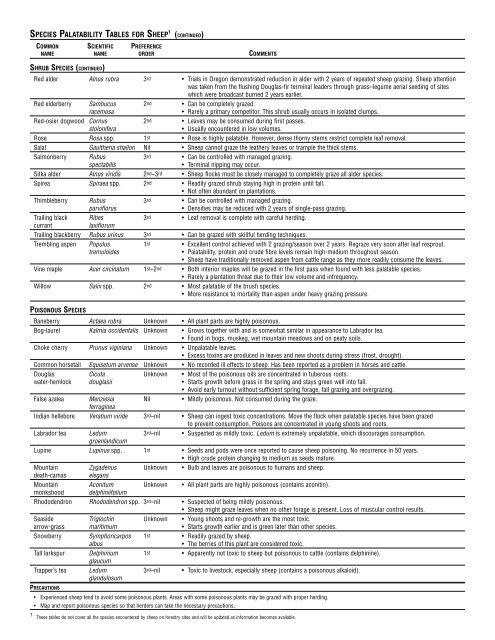You also want an ePaper? Increase the reach of your titles
YUMPU automatically turns print PDFs into web optimized ePapers that Google loves.
SPECIES PALATABILITY TABLES FOR SHEEP 1 (CONTINUED)<br />
COMMON SCIENTIFIC PREFERENCE<br />
NAME NAME ORDER COMMENTS<br />
SHRUB SPECIES (CONTINUED)<br />
Red alder Alnus rubra 3rd • Trials in Oregon demonstrated reduction in alder with 2 years of repeated sheep grazing. Sheep attention<br />
was taken from the flushing Douglas-fir terminal leaders through grass–legume aerial seeding of sites<br />
which were broadcast burned 2 years earlier.<br />
Red elderberry Sambucus 2nd • Can be completely grazed.<br />
racemosa • Rarely a primary competitor. This shrub usually occurs in isolated clumps.<br />
Red-osier dogwood Cornus 2nd • Leaves may be consumed during first passes.<br />
stolonifera • Usually encountered in low volumes.<br />
Rose Rosa spp. 1st • Rose is highly palatable. However, dense thorny stems restrict complete leaf removal.<br />
Salal Gaultheria shallon Nil • Sheep cannot graze the leathery leaves or trample the thick stems.<br />
Salmonberry Rubus 3rd • Can be controlled with managed grazing.<br />
spectabilis • Terminal nipping may occur.<br />
Sitka alder Alnus viridis 2nd–3rd • Sheep flocks must be closely managed to completely graze all alder species.<br />
Spirea Spiraea spp. 2nd • Readily grazed shrub staying high in protein until fall.<br />
• Not often abundant on plantations.<br />
Thimbleberry Rubus 3rd • Can be controlled with managed grazing.<br />
parviflorus • Densities may be reduced with 2 years of single-pass grazing.<br />
Trailing black Ribes 3rd • Leaf removal is complete with careful herding.<br />
currant laxiflorum<br />
Trailing blackberry Rubus urinus 3rd • Can be grazed with skillful herding techniques.<br />
Trembling aspen Populus 1st • Excellent control achieved with 2 grazing/season over 2 years. Regraze very soon after leaf resprout.<br />
tremuloides • Palatability, protein and crude fibre levels remain high-medium throughout season.<br />
• Sheep have traditionally removed aspen from cattle range as they more readily consume the leaves.<br />
Vine maple Acer circinatum 1st–2nd • Both interior maples will be grazed in the first pass when found with less palatable species.<br />
• Rarely a plantation threat due to their low volume and infrequency.<br />
Willow Salix spp. 2nd • Most palatable of the brush species.<br />
• More resistance to mortality than aspen under heavy grazing pressure.<br />
POISONOUS SPECIES<br />
Baneberry Actaea rubra Unknown • All plant parts are highly poisonous.<br />
Bog-laurel Kalmia occidentalis Unknown • Grows together with and is somewhat similar in appearance to Labrador tea.<br />
• Found in bogs, muskeg, wet mountain meadows and on peaty soils.<br />
Choke cherry Prunus viginiana Unknown • Unpalatable leaves.<br />
• Excess toxins are produced in leaves and new shoots during stress (frost, drought).<br />
Common horsetail Equisetum arvense Unknown • No recorded ill effects to sheep. Has been reported as a problem in horses and cattle.<br />
Douglas Cicuta Unknown • Most of the poisonous oils are concentrated in tuberous roots.<br />
water-hemlock douglasii • Starts growth before grass in the spring and stays green well into fall.<br />
• Avoid early turnout without sufficient spring forage, fall grazing and overgrazing.<br />
False azalea Menziesia<br />
ferruginea<br />
Nil • Mildly poisonous. Not consumed during the graze.<br />
Indian hellebore Veratium viride 3rd–nil • Sheep can ingest toxic concentrations. Move the flock when palatable species have been grazed<br />
to prevent consumption. Poisons are concentrated in young shoots and roots.<br />
Labrador tea Ledum<br />
groenlandicum<br />
3rd–nil • Suspected as mildly toxic. Ledum is extremely unpalatable, which discourages consumption.<br />
Lupine Lupinus spp. 1st • Seeds and pods were once reported to cause sheep poisoning. No recurrence in 50 years.<br />
• High crude protein changing to medium as seeds mature.<br />
Mountain Zygadenus Unknown • Bulb and leaves are poisonous to humans and sheep.<br />
death-camas elegans<br />
Mountain Aconitum Unknown • All plant parts are highly poisonous (contains aconitin).<br />
monkshood delphiniifolium<br />
Rhododendron Rhododendron spp. 3rd–nil • Suspected of being mildly poisonous.<br />
• Sheep might graze leaves when no other forage is present. Loss of muscular control results.<br />
Seaside Triglochin Unknown • Young shoots and re-growth are the most toxic.<br />
arrow-grass maritimum • Starts growth earlier and is green later than other species.<br />
Snowberry Symphoricarpos 1st • Readily grazed by sheep.<br />
albus • The berries of this plant are considered toxic.<br />
Tall larkspur Delphinium<br />
glaucum<br />
1st • Apparently not toxic to sheep but poisonous to cattle (contains delphinine).<br />
Trapper’s tea Ledum<br />
glandulosum<br />
3rd–nil • Toxic to livestock, especially sheep (contains a poisonous alkaloid).<br />
PRECAUTIONS<br />
• Experienced sheep tend to avoid some poisonous plants. Areas with some poisonous plants may be grazed with proper herding.<br />
• Map and report poisonous species so that herders can take the necessary precautions.<br />
1 These tables do not cover all the species encountered by sheep on forestry sites and will be updated as information becomes available.

















